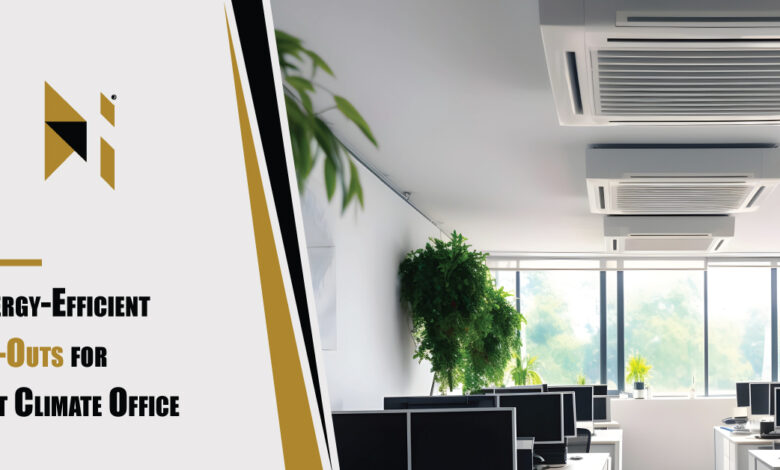Energy-Efficient Fit-Outs for Hot Climate Offices

Designing office interiors in hot climates poses unique challenges that require careful consideration of energy efficiency, occupant comfort, and sustainability. In regions where temperatures routinely soar above 40°C and solar intensity is extreme, traditional office fit-outs often result in excessive energy consumption due to reliance on air conditioning. To address these issues, energy-efficient fit-outs have become essential for modern office environments, especially in hot climates like Saudi Arabia. This article explores key strategies and considerations to optimize office interiors for energy savings while maintaining a comfortable workspace.
Understanding the Impact of Hot Climates on Office Interiors
Challenges of Heat and Sunlight Exposure
Hot climates place significant thermal stress on office buildings. Excessive solar radiation leads to heat gain through walls, windows, and roofs, which increases the cooling load on HVAC systems. Without proper design, offices can become uncomfortable, and energy costs rise dramatically. Moreover, prolonged exposure to intense heat can degrade interior materials, causing fading, warping, or deterioration, which impacts the long-term durability of fit-out components.
Importance of Energy Efficiency
Energy efficiency is not just about reducing electricity bills but also about minimizing the environmental footprint of commercial buildings. Offices with inefficient fit-outs contribute heavily to greenhouse gas emissions due to excessive use of cooling equipment powered by fossil fuels. In hot climates, designing interiors that reduce heat gain and enhance cooling efficiency aligns with broader sustainability goals and regulations that encourage greener building practices.
Choosing the Right Materials for Heat Management
Insulating Walls, Ceilings, and Floors
One of the most critical aspects of energy-efficient office fit-outs is enhancing the building envelope’s insulation. Walls and ceilings should be treated with materials that limit heat transfer, such as insulated plasterboards, rigid foam panels, or mineral wool. Effective insulation reduces the amount of outdoor heat entering the office, which directly decreases the load on air conditioning systems.
Floors in hot climates benefit from materials that remain cool underfoot. Natural stone tiles like marble or ceramic are excellent choices because they do not absorb and retain heat as much as wood or vinyl. These materials also require minimal maintenance, making them suitable for office environments that experience high foot traffic and dust.
Selecting Heat-Resistant Finishes and Furnishings
Interior finishes and furniture must be selected for their ability to withstand high temperatures and UV exposure. Laminates, veneers, and coatings should have UV-resistant properties to prevent fading. Metals used in furniture should have anti-corrosion coatings to resist damage from dry, dusty air. Upholstery fabrics should be breathable and not prone to heat retention to ensure comfort for office occupants.
Optimizing Natural and Artificial Lighting
Utilizing Daylight Without Excess Heat
Natural daylight is essential for productivity and wellbeing in office spaces, but uncontrolled sunlight can raise indoor temperatures. Incorporating tinted or reflective window films can allow natural light to penetrate while blocking harmful UV rays and reducing solar heat gain. Installing insulated glazing windows helps maintain indoor temperatures by preventing heat transfer.
Skylights equipped with operable shading or blinds provide another method to bring in natural light without overheating. Automated shading systems that adjust based on sunlight intensity can optimize light levels and thermal comfort throughout the day.
Implementing Energy-Efficient Artificial Lighting
Traditional lighting sources such as incandescent or halogen bulbs produce substantial heat, adding to cooling demands. Switching to LED lighting significantly reduces heat output while offering energy efficiency and longer lifespan. LEDs consume less electricity and generate minimal heat, making them ideal for offices in hot climates. Strategic placement of LED fixtures can also reduce the number of lights needed, further cutting energy consumption.
HVAC System Integration and Ventilation Strategies
Zonal Cooling for Targeted Efficiency
Large office buildings can benefit greatly from zonal HVAC systems that allow cooling to be controlled independently in different areas. This prevents overcooling unoccupied zones and optimizes energy use according to occupancy and function. By targeting cooling where it is needed most, energy waste is minimized and occupant comfort is enhanced.
Enhancing Ventilation and Air Quality
Ventilation is crucial in hot and dry climates to maintain fresh indoor air and prevent stuffiness. Mechanical ventilation systems with energy recovery ventilators (ERVs) can exchange stale indoor air with fresh outdoor air while conserving cooling energy. Ceiling fans and strategically placed vents help circulate air, supporting passive cooling and reducing reliance on air conditioning.
Layout and Spatial Planning for Thermal Comfort
Designing for Passive Cooling
Office layouts should maximize natural ventilation and shade. Locating frequently used workspaces away from windows facing direct sunlight and clustering service areas such as kitchens or copy rooms can reduce internal heat generation in primary office zones. Features such as internal courtyards, atriums, or shaded outdoor spaces can serve as temperature buffers and promote airflow.
Spatial Zoning to Control Heat Sources
Separating heat-producing equipment and functions from main work areas helps contain and manage heat more effectively. For example, server rooms and kitchens should be isolated with insulated partitions to prevent heat spread. Shared spaces like conference rooms are best located in cooler parts of the building or in areas with less sun exposure to minimize cooling needs.
Sustainable and Smart Technologies in Office Fit-Outs
Using Eco-Friendly Building Materials
Sustainability starts with material selection. Utilizing locally sourced and environmentally friendly materials such as recycled glass, bamboo, or reclaimed wood reduces the environmental footprint of office fit-outs. These materials often have natural properties that contribute to heat resistance and durability.
Low-VOC paints, adhesives, and sealants improve indoor air quality by minimizing harmful emissions, creating healthier work environments in sealed, air-conditioned offices.
Smart Controls and Building Automation
Integrating smart building systems allows precise control of lighting, HVAC, and shading, which can adjust based on occupancy and external weather conditions. Smart thermostats and sensor-driven lighting reduce energy waste by turning off or dimming systems when spaces are unoccupied. Over time, automation enhances operational efficiency and reduces overall energy consumption.
Water Efficiency and Climate-Responsive Practices
Installing Water-Saving Fixtures
Though cooling is a primary concern in hot climates, water conservation is also vital, especially in arid regions. Offices can reduce water use by installing low-flow faucets and sensor-operated fixtures. Water-saving strategies align with sustainability goals and reduce utility expenses.
Incorporating Greywater Reuse Systems
Advanced office buildings may include greywater systems that recycle water from sinks and showers for non-potable uses such as irrigation or toilet flushing. This reduces demand on freshwater supplies and supports sustainable building certifications.
Aesthetic Considerations for Hot Climate Offices
Using Light-Colored Palettes
Light and neutral interior colors such as white, beige, or soft gray reflect heat instead of absorbing it. These shades create a visually cooler environment and complement the energy efficiency of other design strategies.
Emphasizing Minimalism and Cleanability
In dusty and dry climates, minimalistic designs with smooth surfaces are practical. Avoiding heavy fabrics, intricate moldings, and cluttered layouts reduces dust accumulation and simplifies cleaning. Modular furniture and wipeable finishes help maintain hygiene and reduce maintenance efforts.
Conclusion: The Future of Energy-Efficient Office Fit-Outs in Hot Climates
Energy-efficient fit-outs are essential for office buildings in hot climates to address rising energy costs, occupant comfort, and environmental concerns. By combining heat-resistant materials, optimized lighting, advanced HVAC systems, smart controls, and sustainable practices, offices can achieve a balance between functionality and eco-friendliness.
With regulatory pressures and corporate sustainability commitments increasing, investing in energy-efficient fit-outs is not just beneficial but necessary for future-ready workplaces in Saudi Arabia and similar hot regions worldwide.


